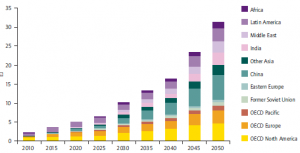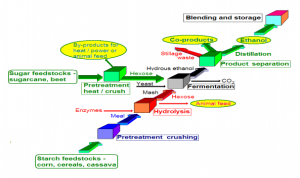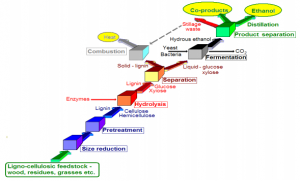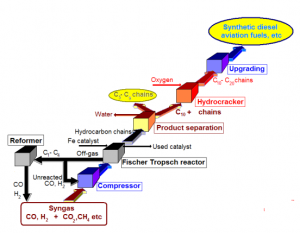All biofuels are currently “1st generation” biofuels, meaning they are produced primarily from food crops (grains, sugars, oil seeds). The production methods for these first-generation biofuels is relatively mature and well understood and has been reasonably well integrated into several country’s markets. The exact routes from biomass to biofuel for biodiesel and ethanol can be seen in detail below.
However, achieving targets for global production, climate change reduction, and economic growth using only “1st generation” biofuels is unlikely. Several criticisms include the relatively low GHG emission avoidance from some of the biofuels. The fuels also require significant government subsidies to remain economically competitive and also compete with food crop feedstocks and water use, further driving up those prices. Development of “2nd generation” biofuels is necessary in order to achieve these targets sustainably and economically. These “2nd generation” biofuels come from ligno-cellulosic materials such as cereal straw, forest residues, vegetative grasses, bagasse, and short rotation forests. These crops can be grown on less arable land and would therefore not compete with food crops, which is one of the current issues of 1st generation biofuels.

With demand expected to increase significantly by 2050, biofuels could provide 27% of the world’s transport energy by that time, leading to a need to further the development of these 2nd generation biofuels.
Currently two main processes under research and development to produce biofuels from ligno-cellulosic feedstocks.
- Biochemical – Enzymes are used to convert the feedstocks to sugars prior to fermentation, producing ethanol.
- Thermo-Chemical – After heating, a gas is produced from which many biofuels, including synthetic diesel, can be reformed.
Future Outlook
While research is well under way, there is still a long way to go before 2nd Generation biofuels will be a commercially viable option. Significant investments into the development of these 2nd generation fuels is needed to achieve necessary improvements. It is most likely that the increase in demand for biofuels in developed regions such as the U.S. and E.U will not be able to be met by their own production so there is potential for developing regions to export significant amounts of second generation biofuels. Countries like Brazil, China, and India have the agricultural and R&D potential to support development of these second generation biofuels but would require significant investments and technical developments over the next ten to fifteen years.
Primary Author: John Marshall
Editor: Harrison Congdon
Resource – Sims, Ralph and Taylor, Michael. “From 1st to 2nd Generation Biofuel Technologies.” International Energy Agency. November 2008. http://www.iea.org/publications/freepublications/publication/2nd_Biofuel_Gen.pdf
Resource – Brown, Adam and Fulton, Lew. “Technology Roadmap, Biofuels for Transport.” International Energy Agency. 2011. http://www.iea.org/publications/freepublications/publication/Biofuels_Roadmap_WEB.pdf




